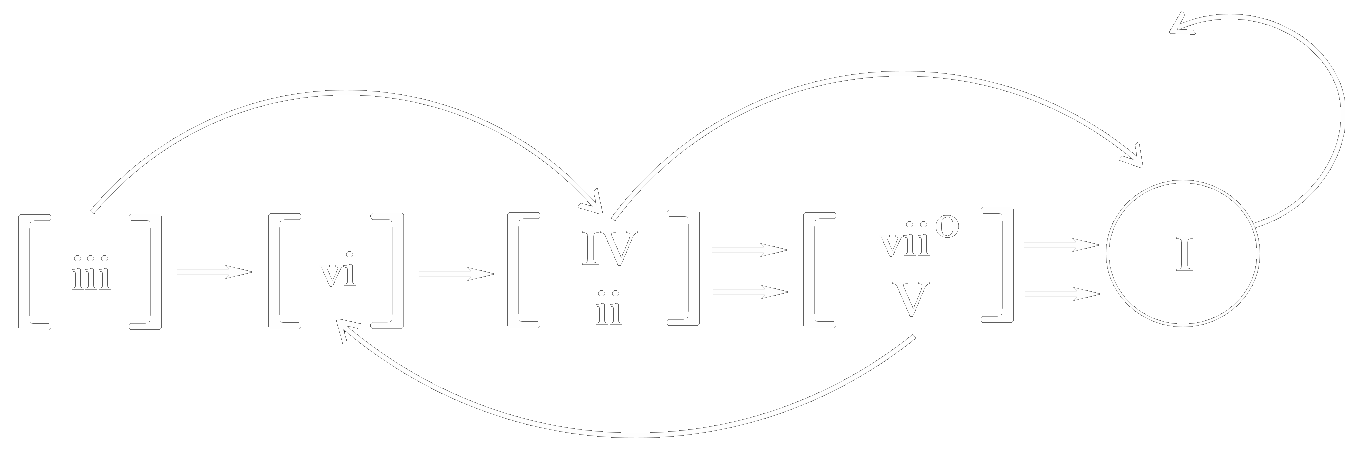Functional Harmony

Diatonic Chords
There are seven so-called “diatonic chords” for each mode of the major scale. They correspond with each tone in the scale, and are built by stacking thirds. The first chord is made by playing the first, third and fifth note from the scale. The second chord is made using the second, fourth and sixth notes. When you run out of notes to stack, wrap back around to the beginning of the scale.
For each major scale, this process creates chords with the following qualities:
- I: Major
- ii: Minor
- iii: Minor
- IV: Major
- V: Major
- VI: Minor
- vii: Diminished
The use of roman numerals is explained here. Note that this only applies to the major scale, and that the order changes depending on which kind of scale is being used.
Understanding the process that creates these chords is not as important as knowing what the chords actually are. Focus your efforts on memorizing the order listed above.
Chord Extensions
While the diatonic series is constructed using the notes from some particular scale, the actual naming of a chord pays respect to the intervals present within the chord. All of these intervals are relative to the chord’s root note.
Chord extensions are created by stacking more than 3 notes when building these chords. By stacking four notes rather than three, you create a series of 7th chords. Excluding one exception, each major chord becomes a major 7th and each minor chord becomes a minor 7th.
The exception is the V chord. When extended by one note, it becomes a dominant 7th chord rather than a major 7th.
The vii chord becomes a m7♭5 chord. The original diminished triad is a minor triad with a flattened fifth, so extending this chord by adding the minor 7th create a m7♭5 chord. A m7♭5 chord is also known as a half-diminished chord (symbol: ø).
You can extend up to 13th chords. When asked to play a particular progression, you can use your own creative discretion when deciding exactly which chords to play. You may choose to use certain extensions that you find most appealing, or most suitable to the current situation.
Roman Numerals
Roman numerals are used to describe a chord or chord progression independently of any particular key. Typically, capital letters denote major chords and lower case letters denote minor chords.
The value of the numeral determines the root note of the chord. The numeral N corresponds to the Nth note in the scale associated with the key you’re playing in. For example, the ii chord in C major would be Dm. The second note in the C major scale is D, and the lower case numerals mean minor.
Roman numerals can also be used to describe non-diatonic chords. The chord D major is not diatonic to the key of C major, but can be described as “II”. The 2nd note in the scale is D, and capital letters means major.
As with most forms of musical notation, this is designed with readability in mind. The point of this system is to enable several musicians to understand the same idea as quickly as possible. This is very helpful in improvisational situations where little preparation has been done beforehand.
Chord Function
These seven chords are considered to “function” in particular ways. They are grouped into three distinct families, namely:
- Tonic (I, iii, vi)
- Sub-dominant (ii, IV)
- Dominant (V, vii)
Each of these families can be considered to have a certain amount of tension relative to the tonic chord. The higher the tension, the more of a pull the chord has towards the tonic. The tonic family has the lowest tension, and the dominant family has the highest. The sub-dominant family acts as an intermediary, bridging the other two families together.
You can see (and hear) this motion in the common ii-V-I progression. It moves from a sub-dominant chord to a dominant chord, driving up the tension before returning to the tonic. In C major, this would be Dm-G-C.
The diagram at the top of this article highlights typical movements between each of the diatonic chords. Pick a starting point and follow the arrows however you please to come up with a chord progression that abides by the rules of functional harmony. The arrow leading away from the I chord indicates that you can chose to move to whichever chord you wish.